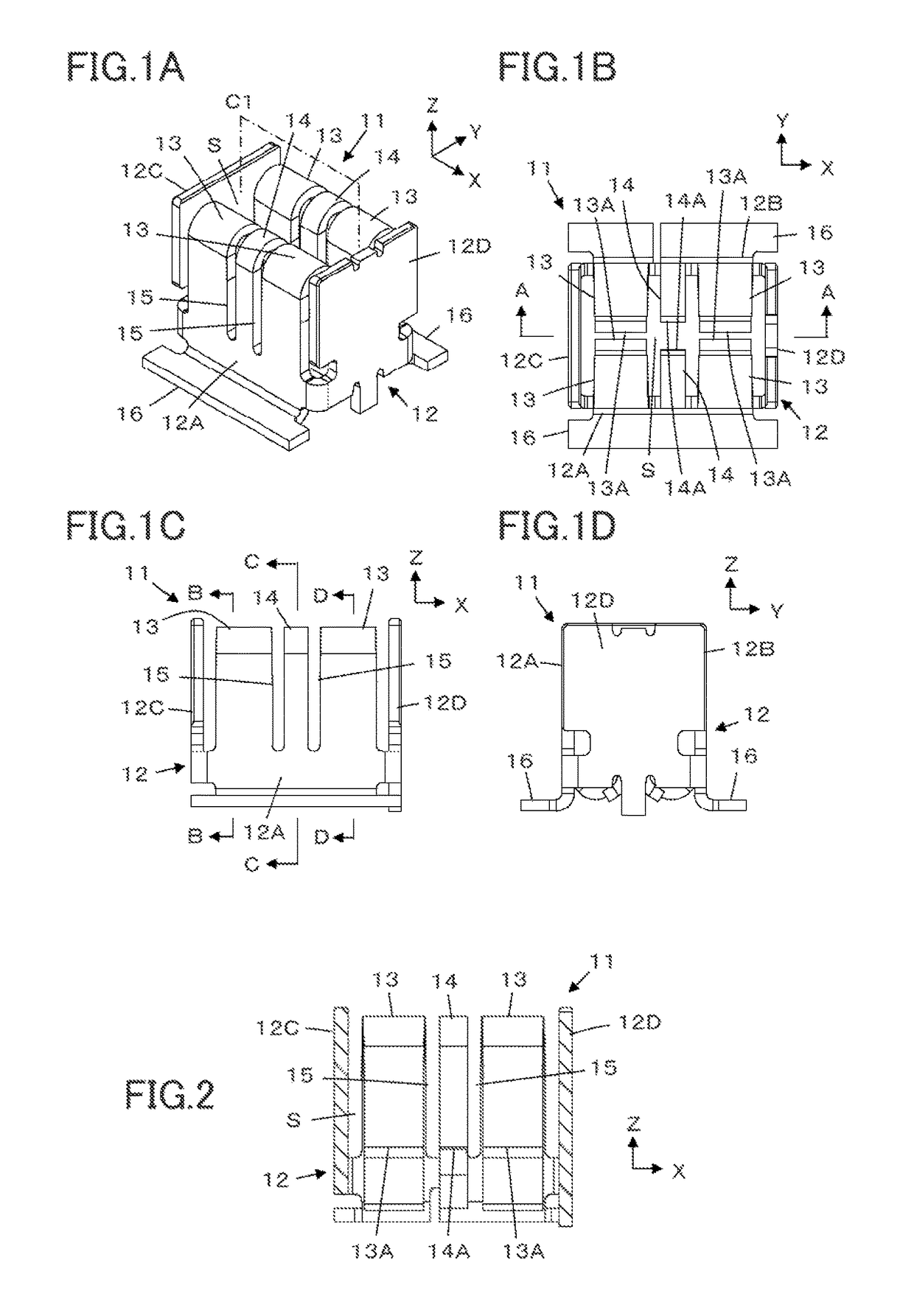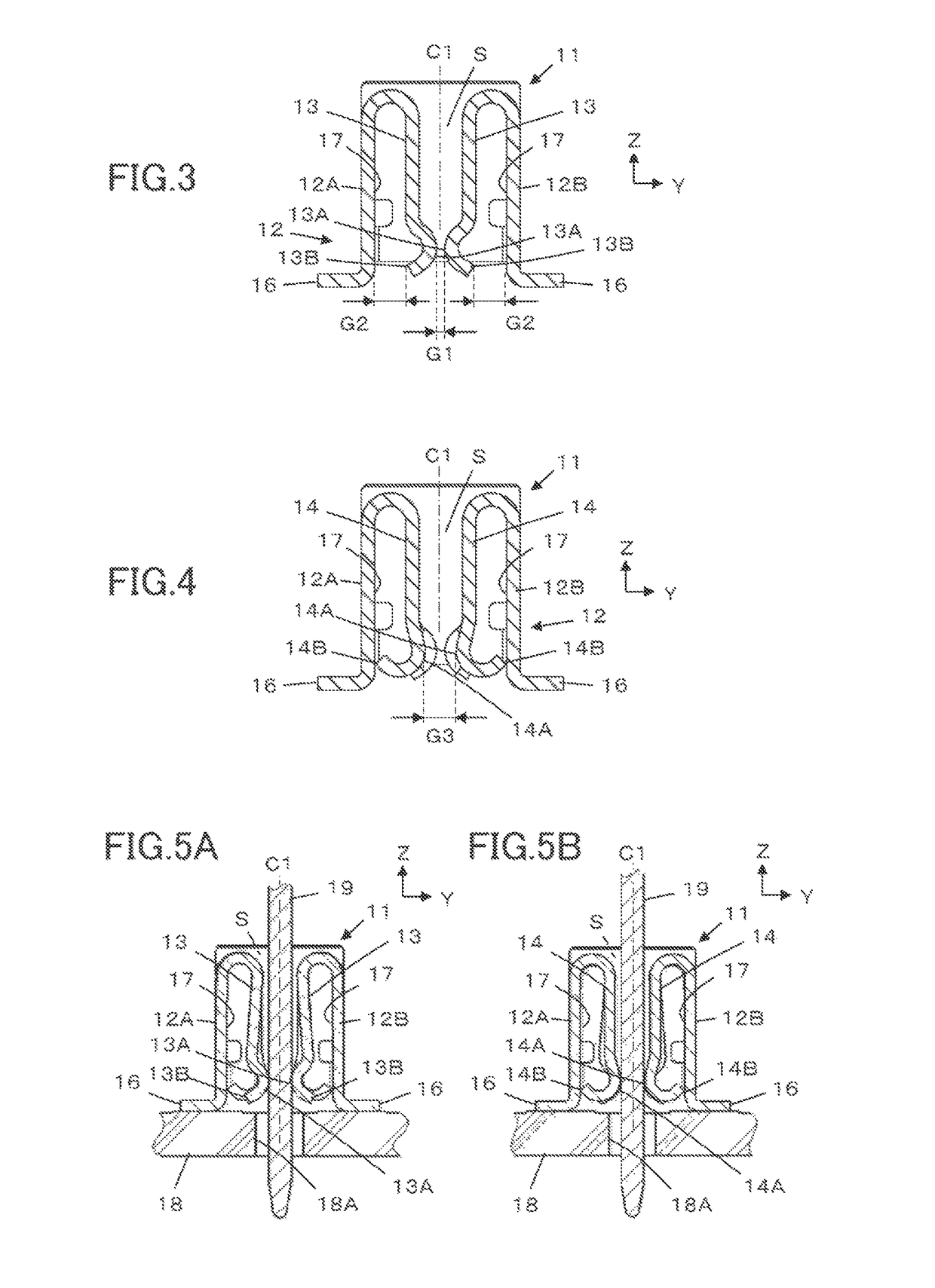Connector
a technology of connecting rods and contacts, applied in the direction of coupling contact members, fixed connections, coupling device connections, etc., can solve the problems of inability to establish reliable electrical conduction, inability to give sufficient contact pressure, and significant uneven /b>, etc., and achieve reliable electrical conduction
- Summary
- Abstract
- Description
- Claims
- Application Information
AI Technical Summary
Benefits of technology
Problems solved by technology
Method used
Image
Examples
embodiment 1
[0026]FIGS. 1A to 1D each illustrate a structure of a socket contact 11 of a connector according to Embodiment 1. The socket contact 11 is to be electrically connected to a counter-connector contact having a plate shape that is inserted along a fitting plane C1, and has a main body portion 12 made from a metal plate that is bent into a box shape. The main body portion 12 includes a front part 12A and a rear part 12B facing each other, and a pair of side surface parts 12C and 12D each joining ends of the front part 12A and ends of the rear part 12B, whereby a reception part S is formed inside the main body portion 12 to receive a counter-connector contact.
[0027]In addition, the socket contact 11 has two pairs of conduction spring pieces 13 that are respectively bent at the upper ends and on both sides of the front part 12A and of the rear part 12B of the main body portion 12 toward the inside of the reception part S and a pair of displacement regulators 14 that are respectively bent ...
embodiment 2
[0057]In the socket contact 11 in Embodiment 1, the front part 12A and the rear part 12B of the main body portion 12 each have two conduction spring pieces 13 disposed on both sides of one displacement regulator 14. However, this is not the sole case.
[0058]In a socket contact 21 of a connector according to Embodiment 2 as illustrated in FIG. 7, a front part 22A and a rear part 22B of a main body portion 22 each have two displacement regulators 24 disposed on both sides of a conduction spring piece 23. That is, the socket contact 21 has a pair of conduction spring pieces 23 and two pairs of displacement regulators 24. Each of the conduction spring pieces 23 and each of the displacement regulators 24 are constituted as identical to the conduction spring piece 13 and the displacement regulator 14 used in Embodiment 1, respectively.
[0059]Having such constitution, the socket contact 21 can realize reliable electrical conduction similarly to the socket contact 11 in Embodiment 1, even if ...
embodiment 3
[0061]In the socket contact 11 in Embodiment 1, the soldering parts 16 are joined to the lower ends of the front part 12A and the rear part 12B of the main body portion 12 respectively so as to face each other across the fitting plane C1. However, as in a socket contact 31 of a connector according to Embodiment 3 illustrated in FIGS. 8A and 8B, soldering parts 36 can be joined to the lower ends of a pair of side surface parts 12C and 12D of the main body portion 12 respectively such that a pair of the soldering parts 36 are disposed to face each other in the direction along the fitting plane C1.
[0062]In the socket contact having such constitution, the soldering parts 36 extending in the Y direction along the side surface parts 12C and 12D are formed. Therefore, a force acting on the conduction spring pieces 13 and the displacement regulators 14 generated by insertion of the counter-connector contact 19 and positional deviation of the contact 19 is received by the soldering parts 16 ...
PUM
 Login to View More
Login to View More Abstract
Description
Claims
Application Information
 Login to View More
Login to View More - R&D
- Intellectual Property
- Life Sciences
- Materials
- Tech Scout
- Unparalleled Data Quality
- Higher Quality Content
- 60% Fewer Hallucinations
Browse by: Latest US Patents, China's latest patents, Technical Efficacy Thesaurus, Application Domain, Technology Topic, Popular Technical Reports.
© 2025 PatSnap. All rights reserved.Legal|Privacy policy|Modern Slavery Act Transparency Statement|Sitemap|About US| Contact US: help@patsnap.com



